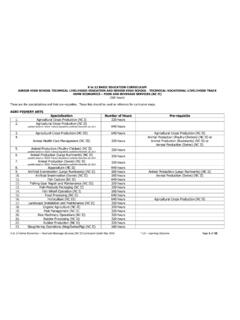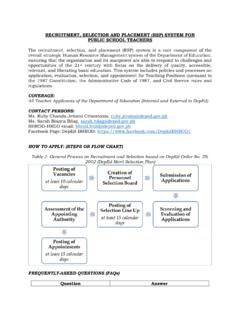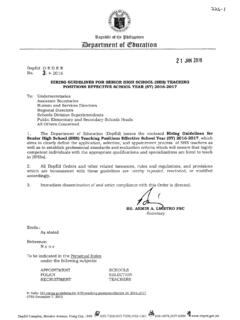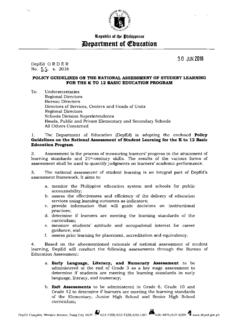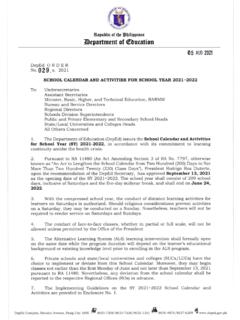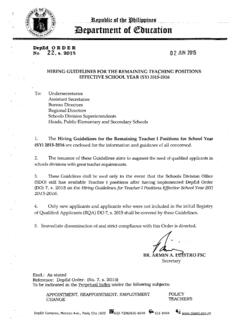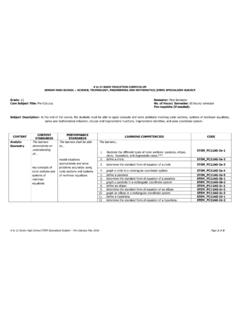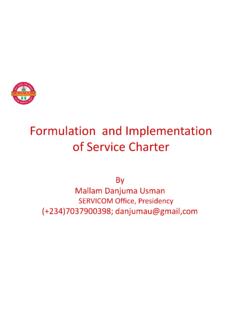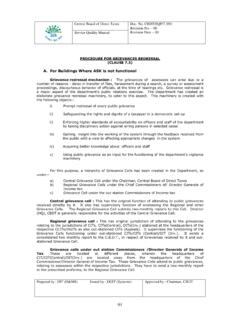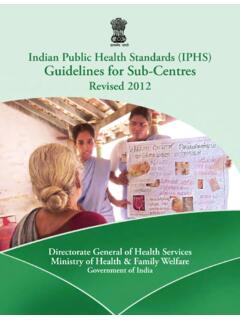Transcription of CITIZEN’S CHARTER HANDBOOK
1 CITIZEN'S CHARTER HANDBOOK . 2021 (1st Edition). 3. DEPARTMENT OF EDUCATION. CITIZEN'S CHARTER . 2021 (1st Edition). 2. I. Brief History of the Philippine Education System Education in the Philippines has undergone several stages of development from the pre-Spanish times to the present. In meeting the needs of the society, education serves as a focus of emphases/priorities of the leadership at certain periods/epochs in our national journey as a race. Table 1. Evolution of the Official Name of Department of Education and Its Titular Head Official Name of Office Titular Year Legal Bases Department Head Department Secretaryship of Decree of June 23. Police and Internal Department 1898 1898 of President Peace and Order, Secretary Emilio Aguinaldo Justice, Education and Hygiene Act. No. 74 of the Department of General Philippine 1901 1916.
2 Public Instruction Superintendent Commission, Jan. 21, 1901. Department of Organic Act Law of 1916 1942 Secretary Public Instruction 1916 (Jones Law). Renamed by the Department of Japanese Executive 1942 1944 Education, Health Commissioner Commission, June 11, and Public Welfare 1942. Department of Renamed by 1944 Education, Health Minister Japanese Sponsored and Public Welfare Philippine Republic Renamed by Department of 1944 Secretary Japanese Sponsored Public Instruction Philippine Republic Department of Renamed by the 1945 1946 Public Instruction Secretary Commonwealth and Information Government Renamed by the Department of 1946 1947 Secretary Commonwealth Instruction Government No. 94 October Department of 1947 1975 Secretary 1947 (Reorganization Education Act of 1947). Department of Proc. No. 1081, 1975 1978 Education and Secretary September 24, Culture 1972.
3 Ministry of No. 1397, June 1978 1984 Education and Minister 2, 1978. Culture 3. Ministry of 1984 1986 Education, Culture Minister Education Act of 1982. and Sports Department of No. 117. January 1987 1994 Education, Culture Secretary 30, 1987. and Sports RA 7722 and RA. Department of 7796, 1994. 1994 2001 Education, Culture Trifocalization of Secretary and Sports Education Management RA 9155, August 2001. 2001 - Department of (Governance of Basic present Education Secretary Education Act). In 1947, by virtue of Executive Order No. 94, the Department of Instruction was changed to the Department of Education. During this period, the regulation and supervision of public and private schools belonged to the Bureau of Public and Private Schools. In 1972, it became the Department of Education and Culture by virtue of Proclamation 1081 and the Ministry of Education and Culture in 1978 by virtue of No.
4 1397. Thirteen regional offices were created and major organizational changes were implemented in the educational system. The Education Act of 1982 created the Ministry of Education, Culture and Sports which later became the Department of Education, Culture and Sports in 1987 by virtue of Executive Order No. 117. The structure of DECS as embodied in EO No. 117 has practically remained unchanged until 1994 when the Commission on Higher Education (CHED), and 1995 when the Technical Education and Skills Development Authority (TESDA) were established to supervise tertiary degree programs and non-degree technical-vocational programs, respectively. The Congressional Commission on Education (EDCOM) report provided the impetus for Congress to pass RA 7722 and RA 7796 in 1994 creating the Commission on Higher Education (CHED) and the Technical Education and Skills Development Authority (TESDA), respectively.
5 The trifocal education system refocused DECS' mandate to basic education which covers elementary, secondary and non-formal education, including culture and sports. TESDA now administers the post-secondary, middle-level manpower training and development while CHED is responsible for higher education. In August 2001, Republic Act 9155, otherwise called the Governance of Basic Education Act, was passed transforming the name of the Department of Education, Culture and Sports (DECS) to the Department of Education (DepEd). and redefining the role of field offices (regional offices, division offices, district offices and schools). RA 9155 provides the overall framework for (i) school head empowerment by strengthening their leadership roles and (ii) school- based management within the context of transparency and local accountability.
6 The goal of basic education is to provide the school age population and young 4. adults with skills, knowledge, and values to become caring, self-reliant, productive and patriotic citizens . II. DepEd Management Structure To carry out its mandates and objectives, the Department is organized into two major structural components. The Central Office maintains the overall administration of basic education at the national level. The Field Offices are responsible for the regional and local coordination and administration of the Department's mandate. In 2015, the Department underwent a restructuring of its office functions and staffing. The result of which was the Rationalization Plan for the new organizational structure. Details of the new structure are further explained in DepEd Order No. 52, series 2015 also known as the New Organizational Structures of the Central, Regional, and Schools Division Offices of the Department of Education.
7 Figure 1. DepEd Organizational Structure per DO. 52 s, 2015. Following the Rationalization Plan structure, the Office of the Secretary (OSEC). at the Central Office oversee and manages five (5) different strands and supported by bureaus, services , and divisions. DepEd operates with nine (9). Undersecretaries and five (5) Assistant Secretaries in the following areas: 5. Curriculum and Instruction Finance and Administration Governance and Operations Legal and Legislative Affairs Strategic Management Field Operations Five (5) attached agencies: Early Childhood Care and Development (ECCD) Council National Book Development Board (NBDB). National Council for Children's Television (NCCT). National Museum Philippine High School for the Arts Three (3) coordinating councils: Adopt-a-School Program (ASP) Coordinating Council Literacy Coordinating Council (LCC).
8 Teacher Education Council (TEC). Figure 2. DepEd Organizational Structure per DO. 52 s, 2015. REGIONAL OFFICE. At the sub-national level, the Field Offices consist of the following: Seventeen (17) Regional Offices including the Bangsamoro Autonomous Region in Muslim Mindanao (BARMM*), each headed by a Regional Director (a Regional Secretary in the case of BARMM). 6. Two hundred twenty-six (226) Schools Divisions Offices headed by a Schools Division Superintendent, and two thousand six hundred forty- five (2,645) schools districts. Figure 3. DepEd Organizational Structure per DO. 52 s, 2015. SCHOOLS DIVISION OFFICE. Under the supervision of the Schools Division Offices are 47,421 public schools, broken down into Curricular Offering below. Note that data provided is as of November 15, 2021. 37,496 Elementary Schools 1,506 Junior High Schools (JHS).
9 231 Senior High Schools (SHS). 6,491 Schools with both JHS and SHS. 1,159 Integrated Schools (Kinder to Grade 10). 538 Integrated Schools (Kinder to Grade 12). III. Mandate: The Department of Education was established through the Education Decree of 1863 as the Superior Commission of Primary Instruction under a Chairman. The Education agency underwent many reorganization efforts in the 20th century in order to better define its purpose vis a vis the changing administrations and charters. The present-day Department of Education's mandate was established through Republic Act 9155, otherwise known as the Governance of Basic Education Act of 2001. 7. The aforementioned RA substantially provides that the Department of Education (DepEd) formulates, implements, and coordinates policies, plans, programs and projects in the areas of formal and non-formal basic education.
10 It supervises all elementary and secondary education institutions, including alternative learning systems, both public and private; and provides for the establishment and maintenance of a complete, adequate, and integrated system of basic education relevant to the goals of national development. IV. Vision: We dream of Filipinos who passionately love their country and whose values and competencies enable them to realize their full potential and contribute meaningfully to nation building. As a learner-centered public institution, the Department of Education continuously improves itself to better serve its stakeholders. V. Mission: To protect and promote the right of every Filipino to quality, equitable, culture-based, and complete basic education where: a. Students learn in a child-friendly, gender-sensitive, safe, and motivating environment.
